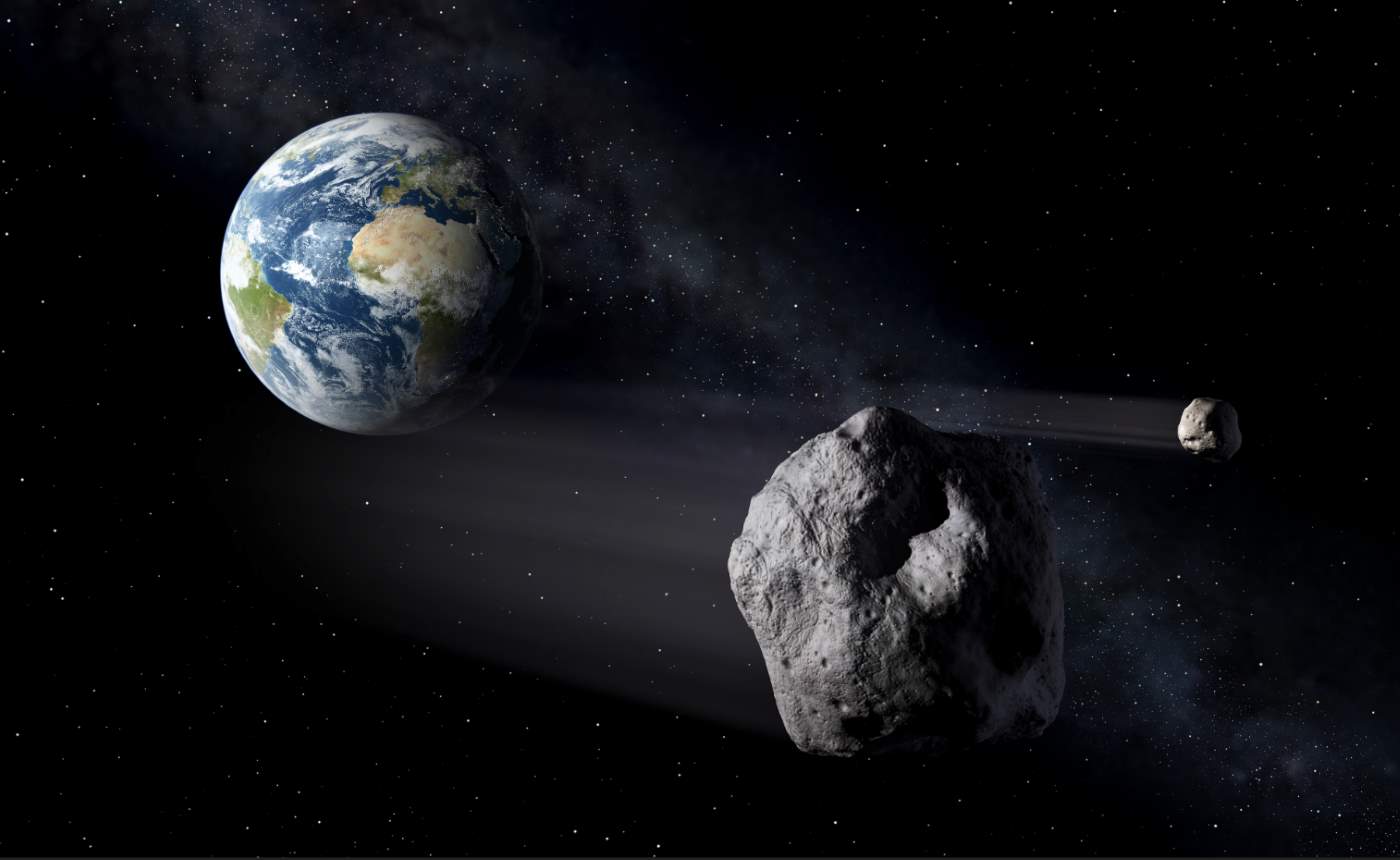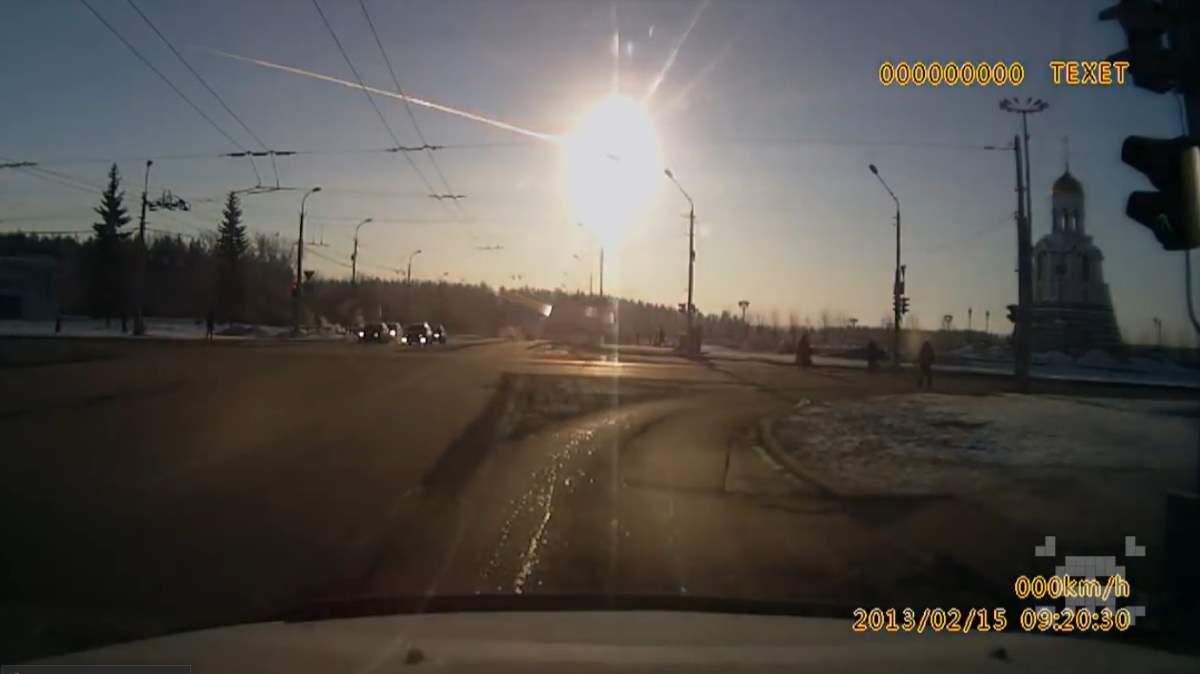On 15 February 2013, an approximately 20-meter (66 feet) meteoroid (see notes 1) entered Earth’s atmosphere over Russia with a speed of 19.16 ± 0.15 kilometers per second (60,000-69,000 km/h or 40,000-42,900 mph). Its mass is estimated at 7,000 to 10,000 tons, one of the largest meteoroids that entered Earth’s atmosphere in recent history. Then, at 9:20 am local time (03:20 UTC), it exploded some 20 to 30 kilometers above the city of Chelyabinsk and created a gigantic fireball (known as a superbolide, see notes 1) brighter than the Sun.
An estimated 500 kilotons of energy was released by the explosion. For comparison, the “Little Boy”, the atomic bomb dropped on the Japanese city of Hiroshima on 6 August 1945 exploded with an energy of approximately 15 kilotons of TNT. So, the Chelyabinsk meteor’s explosion was about 33 times stronger. The shock waves damaged several thousand buildings and injured approximately 1,500 people. No deaths were reported.

Scientists estimate such events occur on average once every 100 years. The most well-known was the Tunguska event, which occurred near the Stony Tunguska River in Yeniseysk Governorate (now Krasnoyarsk Krai), Russia, on the morning of 30 June 1908. It is also the largest impact event on Earth in recorded history. Studies have yielded different estimates of the meteoroid’s size, on the order of 60 to 190 meters (200 to 620 feet), depending on whether the body was a comet or a denser asteroid.
8 months after the incident, the meteorite, weighing in at 570 kg, was pulled out of Lake Chebarkul, making it one of the biggest meteorites ever recovered.
The magnitude of the Chelyabinsk event is the largest known since the Tunguska impact. But, the Tunguska event caused no known human casualties, because it exploded over the sparsely populated Eastern Siberian Taiga. The huge explosion flattened 2,000 square kilometers (770 square miles) of forest, though. The Chelyabinsk meteor is the only meteor confirmed to have resulted in a large number of injuries.
But, why these space rocks explode before they reach Earth?
Why meteoroids explode in the atmosphere?
Scientists long knew that meteoroids often blew up before they reach the Earth’s surface, but they didn’t know why. In December 2017, a team of researchers published a study (see sources) titled “Air penetration enhances fragmentation of entering meteoroids” in Meteoritics & Planetary Science. The study, signed by Purdue University scientists M. E. Tabetah and H. J., proposes a new and previously overlooked mechanism for air penetration in meteoroids, which could help explain the powerful explosions of Chelyabinsk or Tunguska events.
According to the new study, which was supported by NASA’s Office of Planetary Defense under grant NNX14AL15G, the breakup of the meteoroid was characterized by intense fragmentation that dispersed most of the original mass. The researchers implemented a two-material computer code that allows them to fully simulate the exchange of energy and momentum between the entering meteoroid and the interacting atmospheric air. Simulations revealed a previously unrecognized process in which the penetration of high-pressure air into the body of the meteoroid greatly enhances the deformation and facilitates the breakup of meteoroids similar to the size of Chelyabinsk.
As a meteoroid hurtles through Earth’s atmosphere, the high-pressure air in front of it seeps into its pores and cracks. This process creates a great amount of internal pressure too, which pushing the body of the meteor apart and causing it to explode.

The Chelyabinsk meteoroid weighed around 10,000 tons, but only about 2,000 tons of debris were recovered. Something happened in the upper atmosphere that caused it to disintegrate, but previous computer simulations couldn’t solve the puzzle. Jay Melosh, a professor of Earth, Atmospheric, and Planetary Sciences at Purdue University, and the study’s co-author said that “Most of the computer codes we use for simulating impacts can tolerate multiple materials in a cell, but they average everything together. Different materials in the cell use their individual identity, which is not appropriate for this kind of calculation.”
Only using the unique two-material fluid dynamics code unique computer code allowed researchers to generate models that let both air and solid material coexist in any part of the calculation.
This new mechanism shows that the Earth’s defense against small rocky meteoroids is stronger than it is thought. But, it seems the really big ones, like the Chicxulub impactor, likely won’t be bothered by it. Melosh says iron meteoroids are much smaller and denser, and even relatively small ones tend to reach the surface.

Notes
- A meteoroid is a small rocky or metallic body, significantly smaller than an asteroid, in outer space. When a meteoroid (or a comet, or an asteroid) enters Earth’s atmosphere at a speed typically in excess of 20 km/s (72,000 km/h; 45,000 mph), aerodynamic heating of that object produces a streak of light, both from the glowing object and the trail of glowing particles that it leaves in its wake. This phenomenon is called a meteor. If a meteor survives its passage through the atmosphere to reach the surface of a planet or moon, it’s called a meteorite. If a meteor is extremely bright, then it’s called a bolide. One definition describes a bolide as a fireball reaching an apparent magnitude of -14 or brighter – more than twice as bright as the full moon. A superbolide is a bolide that reaches an apparent magnitude of -17 or brighter A superbolide can be brighter than the Sun, which has an apparent magnitude (m) of -26.74. The apparent magnitude (m) of a celestial object is a number that is a measure of its brightness as seen by an observer on Earth.
Sources
- Study: Air penetration enhances fragmentation of entering meteoroids on Wiley Online Library
- “Why do meteoroids explode in the atmosphere?” on Astronomy.com
- “Research shows why meteoroids explode before they reach Earth” on Eureka Alert
- Meteoroid on Wikipedia
- Tunguska event on Wikipedia
- Chelyabinsk meteor on Wikipedia
- Little Boy on Wikipedia
- Bolide on Wikipedia
- Budget of NASA, Year by Year [1980-1989] - June 10, 2024
- Budget of NASA, Year by Year [1970-1979] - June 10, 2024
- Budget of NASA, Year by Year [1958-2024] - June 10, 2024


